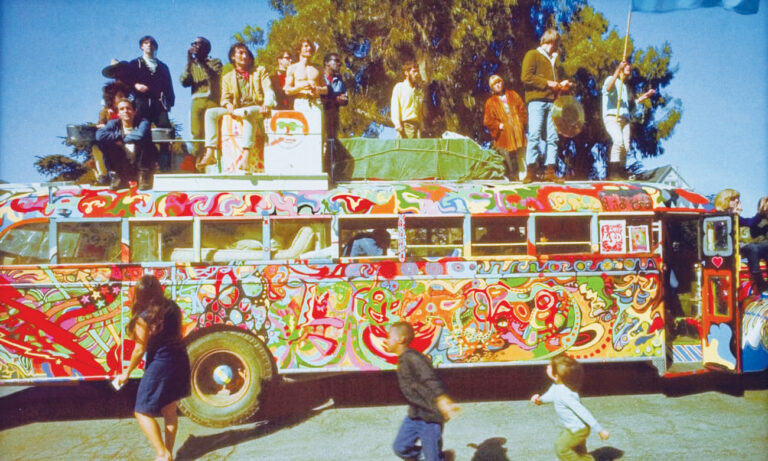Tranquilina Ramirez sits at a table outside a Freedom, California grocery store on a brisk March evening. Originally from Oaxaca, Mexico, the mother of seven has been a local farmworker for 14 years.
Now, like countless other workers in the Pajaro area, she is in limbo after the devastating impact of the recent winter storms. Storms have raged intermittently since January, with the most recent one causing the Pajaro River levee to suffer a catastrophic failure, flooding the town of Pajaro and creating a nightmare scenario for the already-devastated region. The destruction has created a dire situation for families like hers, whose livelihoods depend on the local land.
“We’re looking for work, but there is nothing out there. We are used to working the fields, but there is nothing,” she says in Spanish. “It’s hard for us campesinos because it’s taking a long time, and we have to wait and see if there is work. And if there is, it will be a lot less.”
Ramirez has worked in the fields since she was 18 and speaks Mixteco primarily. At this time last year, she was at least working about 15 hours a week weeding the strawberry fields, but the storms have drastically cut down working hours for farmworkers.
That’s because more than two months after the first major storms hit in late December 2022, agricultural fields are still flooded, leaving farmworkers across the county without income for the foreseeable future.
“There is not much support for immigrants and campesinos. Many of us need help right now,” says Ramirez. “Some people don’t have a place to live or can’t pay their rent.”
She has considered seeking work at local packaging plants but says that openings are hard to come by, especially in the off-season when many farmworkers flock to these jobs.
Meanwhile, her debt is mounting—her family of nine rents a one-bedroom apartment for $1,800 a month. They would rather go hungry than not pay the rent and lose their dwelling. They have resorted to taking out loans from friends and other family members. From January to now, they have borrowed $4,000 for rent and bills, with no anticipated relief coming down the pipeline.
Ramirez isn’t alone. South Santa Cruz County has the highest concentration of undocumented workers and migrants, many of whom are only eligible for federal aid if they meet a narrow criterion.
Tiana Suber, a Media Relations Specialist for FEMA, clarified the requirements.
“If they are undocumented and they have somebody in their household who is a U.S. citizen, then they can apply in their name,” Suber says.
Those who qualify may receive up to $40,000 in federal grants to help homeowners and renters pay for repairs.
But even if some farmworkers qualify through a household member, fearing deportation and having their families broken apart stops many from applying, according to Ramirez.
When asked what will happen to families that do not meet the criteria for federal aid, Suber points to local organizations as a solution.
“They can get help from other agencies. The state and the county offer a lot of resources as well for those that don’t qualify, and [they] can get help from these other resources and non-profits as well,” Suber says.
SAFETY NET
Dr. Ann Lopez, founder of the Center for Farmworker Families, calls the conditions that local farmworkers experience “horrible.”
“They’ve been hit on all fronts. I’ve never seen a catastrophe hit farmworkers on this scale,” says Dr. Lopez. “Within a three-year period, they’ve lived through the Covid pandemic, heat waves that have made farmworkers faint in the fields and now the aftermath of the winter storms.”
Since its founding, the center has worked to gain the trust of migrant farmworker families who are wary of government programs, helping them through weekly food and toiletry distribution.
“They know we are not the migra. When you mention an institution that is federal or state, it gets scary for them,” Dr. Lopez says.
At a recent food distribution that primarily serves farmworkers, about 700 families sought help. During the agricultural off-season, which typically runs from November through January, the Center serves about 250 families in need. This year, that number has nearly tripled, according to Dr. Lopez.
“Just this morning, I spoke to people from Watsonville, Salinas and Castroville who were literally begging for food. So, the need is tremendous. And so many people have lost everything, and there is no work.”
Ernestina Solorio, a local farmworker and advocate from Watsonville, agrees that the current situation is disastrous for these working families and that they have limited options. That’s because agricultural workers don’t have resources like unemployment benefits and aren’t able to qualify for government aid that a person with legal status might be able to obtain, he says.
Philanthropic foundations such as the Community Foundation of Santa Cruz County and the Community Foundation of Monterey County have stepped in to help organizations provide relief. Alongside the Center for Farmworker Families, the Community Action Board of Santa Cruz County and Community Bridges are also joining in to help South County.
Tony Nuñez, the communications manager for Community Bridges, says one of the biggest needs is rental assistance for people who are out of work, have had to leave their homes or have lost their homes.
Santa Cruz is the second-most expensive rental market in the country, according to a recent study. The market rate for a two-bedroom apartment is $3,138, which would require an estimated wage of over $60 an hour. Much like other working-class residents of the county, farmworkers make an average of $14 an hour.
“The Community Foundation gave us thousands and thousands of dollars to write rental assistance checks for farmworkers so they wouldn’t lose the places where they lived. And we do whatever we can,” says Dr. Lopez.
Community Action Board (CAB) has received $300,000 from the Community Foundation of Santa Cruz County for rental assistance and expects another $300,000. However, CAB’s role is restricted to housing relocation and wage replacement for those that qualify based on their legal status. Households qualifying can receive up to $1,500 as a one-time payment, but that is only a temporary solution.
“How are they going to pay for everything moving forward?” asks Elyssa Sanchez, Program Coordinator for CAB’S Homelessness Prevention and Intervention Services. She says these families’ financial hardships are compounding as weeks pass, and another cycle of rent and bills is on the horizon.
Despite the daunting tasks ahead for these organizations, the current situation has galvanized their role in the community.
“Something is happening in South County,” says MariaElena De La Garza, Executive Director of CAB in Santa Cruz County, “and it’s called organizing.”
COUNTY INEQUITIES
The national spotlight recently focused on the humanitarian crisis unfolding in South Santa Cruz County. It took a tragedy in Pajaro to get the country’s attention.
According to Paz Padilla, Director of Programs and Impact for CAB, South County was largely unrepresented when President Biden visited the region and held a press conference with local officials in January. It reminded her of the media coverage following the 1989 Loma Prieta earthquake, which focused on San Francisco and Oakland, effectively neglecting Watsonville, one of the hardest-hit areas in the county.
On March 15, Governor Gavin Newsom arrived in Pajaro and toured the area with local leaders, promising cash payments of $600 were underway for those affected, regardless of immigration status. In an interview with the San Francisco Chronicle, Raymon Cancino, CEO of Community Bridges, called the gesture a “slap in the face” and said that more help was needed. He noted that the $600 payments were initially intended as Covid-19 pandemic relief and were not aimed at assisting flood victims.
When asked what she thought about the lack of media attention before the Pajaro flood, Ernestina Solorio hoped people realized the benefits they get from farmworkers in the local area and that they should support them in any way they can. This rings even truer now.
“You never know the sacrifice and efforts that go into picking the food we eat. Campesinos may not be from here, but we are contributing to this country.”
David Blume, CEO of Whiskey Hill Farms in Watsonville, expects that the destruction from recent storms that have flooded local farms and led to farmworker job losses will start to have ripple effects across the county.
Consumers will soon feel an economic impact on the local and national levels. Blume says that shortages and higher prices for broccoli and cauliflower, both grown in the region, will be the effect of the massive regional crop loss.
Nishan Moutafian, Vice President of Production for Driscoll’s Inc, estimates that at least 1,500 acres of their strawberry fields have been affected by the recent flooding. And those that haven’t flooded are still over a month away from significant production, he says. However, he thinks the smaller growers will bear the brunt of the economic hit.
“Seventy five percent of the people who live in Watsonville are farmworkers and Hispanic. And without them, we’d all be lost,” Blume says.
























